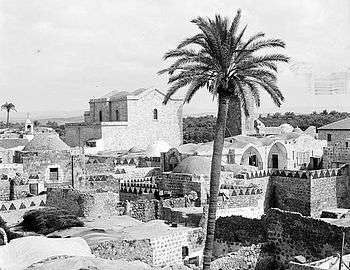Church of Saint George, Lod
Church of Saint George (Arabic: كنيسة القديس جيورجوس or كنيسة مار جريس, Hebrew: כנסיית גאורגיוס הקדוש קוטל הדרקון) is one of the two major shrines for the fourth-century Christian martyr Saint George. The church is located in Lod, Israel.[1] The current church, built in 1870, shares space with the El-Khidr Mosque (الخضر Al-Khidr, often associated with Saint George).
| Church of Saint George | |
|---|---|
 Rooftop view, Lydda c. 1920 | |
| Religion | |
| Affiliation | Greek Orthodox |
| Location | |
| Location | Lod, Israel |
| Geographic coordinates | 31°57′10.8″N 34°53′58.15″E |
| Architecture | |
| Completed | 1872 |
History
Toward the end of the nineteenth century, the Greek Orthodox Patriarchate of Jerusalem received permission from the Ottoman authorities to build a church on the site of a previous basilica. The church is built over a ruined 12th-century Crusader structure, and occupies the north end of the nave and left-hand aisle of the earlier church, from which two apses survive - which, contrary to the normal rule, face north rather than east.[2]
The Ottoman authorities stipulated, that part of the plot be made available for a mosque. Mosque far older than rebuilt 19th century Greek church, is Mamluk from 14th century. Consequently, the current Church of St. George incorporates only the northeast corner of the Byzantine basilica. The remains of the Byzantine basilica including its are incorporated into the mosque; the Crusader church took a different, if adjacent, location. Some of it, too, is part of the mosque complex. The prayer hall of the adjacent mosque contains a column that once stood in the nave of the basilica.[2]
The church crypt contains the sarcophagus of St George.
Gallery
 1487 drawing of ruined church over St George's tomb and Mosque by Konrad von Grünenberg
1487 drawing of ruined church over St George's tomb and Mosque by Konrad von Grünenberg_-_Bruyn_Cornelis_De_-_1714.jpg) 1714 drawing of ruined church over St George's tomb by Cornelis de Bruijn
1714 drawing of ruined church over St George's tomb by Cornelis de Bruijn- St George's tomb
- Bas-relief on the sarcophagus
.jpg) Interior
Interior
Further reading
- Clermont-Ganneau, C.S. (1896). [ARP] Archaeological Researches in Palestine 1873-1874, translated from the French by J. McFarlane. 2. London: Palestine Exploration Fund. (pp. 102-109)
- Conder, C.R.; Kitchener, H.H. (1882). The Survey of Western Palestine: Memoirs of the Topography, Orography, Hydrography, and Archaeology. 2. London: Committee of the Palestine Exploration Fund. (pp. 267-8)
- Guérin, V. (1868). Description Géographique Historique et Archéologique de la Palestine (in French). 1: Judee, pt. 1. Paris: L'Imprimerie Nationale. (p. 330)
- Moudjir ed-dyn (1876). Sauvaire (ed.). Histoire de Jérusalem et d'Hébron depuis Abraham jusqu'à la fin du XVe siècle de J.-C. : fragments de la Chronique de Moudjir-ed-dyn. (pp. 210-211)
- Robinson, E.; Smith, E. (1841). Biblical Researches in Palestine, Mount Sinai and Arabia Petraea: A Journal of Travels in the year 1838. 3. Boston: Crocker & Brewster. (pp. 49-55)
See also
- Saint George in devotions, traditions and prayers
- St. George's Cathedral, Jerusalem, an Anglican church in Jerusalem, dedicated to the same saint.
- Monastery of Saint George, al-Khader, a Greek Orthodox monastery in the Palestinian town of Khader near Bethlehem.
References
- "Excursions in Terra Santa". Franciscan Cyberspot. Archived from the original on 23 October 2012. Retrieved 22 February 2007.
- Pringle, Denys (1998). The Churches of the Crusader Kingdom of Jerusalem: L-Z (excluding Tyre). II. Cambridge University Press. ISBN 0 521 39037 0. (pp. 9-15)
External links
| Wikimedia Commons has media related to Saint George church in Lod. |